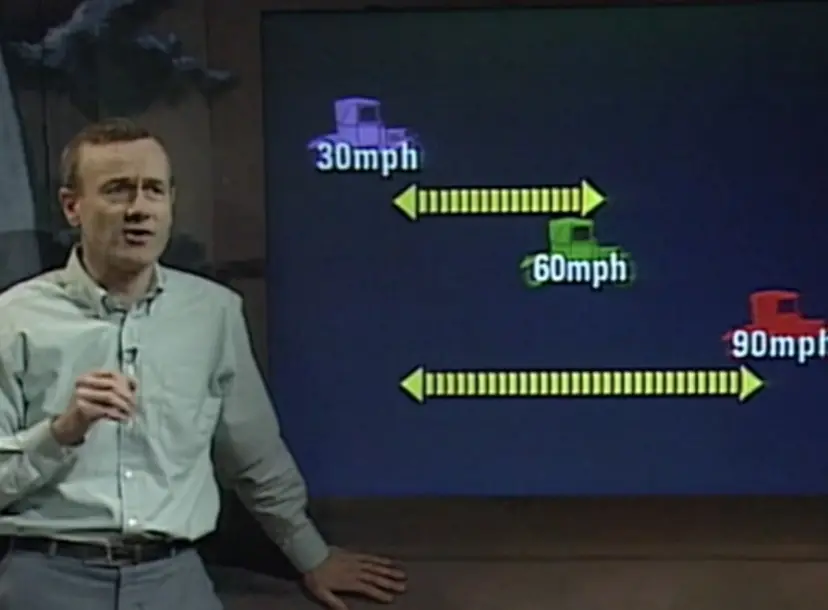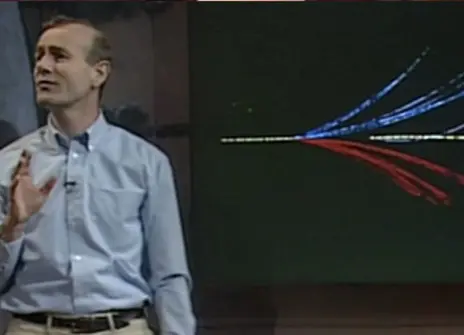Lecture 5 – An hour to make the universe
From the 1993 Lecture programme:
The discoveries from LEP, and throughout the century, make it increasingly surprising that we are here at all! According to our best theories, the Universe erupted in a big hang of hot radiation from which matter and antimatter were born in equal amounts.
Yet out of this uniform symmetric newborn Universe, somehow 20 billion years later all the antimatter has disappeared leaving matter, such as us, and the microwave background radiation remnant of the original heat. How did a uniform Universe end up skewed?
There are several examples in nature of phenomena that appear to be symmetric under one set of conditions and that hide the symmetry under other circumstances. A bath of water consists of molecules uniformly distributed in all 3-dimensions and all directions; but when frozen this uniformity is replaced by the hexagonal symmetry of the snowflake. It is beautiful but more ordered than its hot counterpart, analogous perhaps to the highly structured cool Universe of 20 billion years in contrast to the uniform and hot initial state.
Physicists are now on the trail of the mechanism that hid this original symmetry. They are planning to use the facilities at the LEP in CERN to build a more powerful machine known as LHC (Large Hadron Collider).
The cosmologists tell us that 90% of the Universe consists of mysterious 'Dark Matter': this could be formed at LHC as this accelerator will produce conditions 100 times nearer to the Big Bang than ever seen before, taking us into an epoch before the veil dropped that hid the original symmetries of the Natural Laws, and begin to resolve the deep conundrum of our existence.
About the 1993 CHRISTMAS LECTURES
In our 1993 CHRISTMAS LECTURES, particle physicist Frank Close OBE looks at how our understanding of particle physics developed over the 20th century.
From the 1993 Lecture programme:
The lectures will trace a hundred years of discovery and invention, culminating with a look into the crystal ball towards the next century. The developing story begins in 1893, when the Royal Institution lecturer inhabits a world ignorant of radioactivity, electrons and the working of atoms, knowing nothing of how stars shine, nor of galaxies let alone that they are rushing outwards from a primeval big bang.
Even so, scientists were confident that they were on the brink of describing all basic natural phenomena. Fundamental discoveries at the turn of the century changed all that. Hints that “all was not well” turned out to be true and revolutionary rather than requiring tinkering with a few ideas.
A century later, in 1993, one hears talk of a 'Theory of Everything' and there is debate as to whether we can 'know the mind of God'. Yet even now there are hints that 'all is not well'. The lectures will bring us to the current frontier and try to learn from the experiences of the intervening century of discovery and controversy.
The theme will show how discoveries of natural phenomena provide new tools that, in turn, open up new areas of research leading to further insights, innovation and technologies. The developments feedback, creating new opportunities which often are far removed from the original discovery. The net result is that we are continually extending and deepening our experiences of Nature beyond those accessible to our five senses.
Our five senses reveal the beauty of the everyday world, enabling us to look out to nearby stars, to focus on objects as small as the width of a human hair and to react to events as brief as 1/25th of a second. Many other animals have sharper senses than ours but our ingenuity and inventiveness in effect extend our senses with telescopes, microscopes and other sophisticated tools. Thus it is our 'sixth sense' that expands our watch on the Universe, reveals images deep within individual atoms and discovers Nature at work on timescales of less than a microsecond.
Telescopes on satellites above the atmosphere capture light that was born when the galaxies first formed. Experiments in high energy particle accelerators on Earth teach us how to decode these messages that reveal our origins: we are looking back to (nearly) the Big Bang.
At another extreme we can photograph and display the entire life of a single subatomic particle lasting a mere thousand millionth of a second – an essential part of Nature’s scheme but hidden from our five senses. As hieroglyphics contained the secrets of the Pharaohs, so do these modern pictographs from CERN begin to reveal the story of creation. Not only can we see how the stuff of the present Universe was formed, we also have clues to its possible fate.





